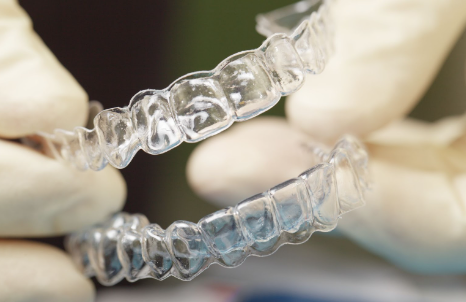How Does Invisalign Move Teeth?
Have you ever wondered how Invisalign can move your teeth into the perfect position? Unlike traditional metal braces, Invisalign uses a series of custom-made clear aligners to gently shift your teeth over time. These aligners apply controlled pressure to the periodontal ligament, gradually guiding your teeth into their desired positions.
Invisalign aligners are trays that work wonders in gradually shifting the teeth of teenagers to achieve that desired smile.
If you’re seeking a convenient and discreet way to straighten your smile, clear aligners like Invisalign might be just what you need. With its custom-made aligners and gradual tooth movement, it’s no wonder why so many people choose this innovative treatment option.

Understanding How Invisalign Aligners Works?
Invisalign aligners have revolutionised the field of orthodontics by providing a discreet and convenient alternative to traditional metal braces. But how exactly do these transparent aligners move teeth? Let’s delve into the fascinating process behind Invisalign’s clear aligners tooth alignment magic.
Picture this: a simple and efficient process that helps reshape your teeth without the hassle of braces or aligners. With composite bonding, we can artfully mould a composite resin material onto your teeth, gently correcting their alignment and creating a beautifully harmonious smile.
Gentle and Controlled Force
One of the key principles behind Invisalign clear aligners is the application of gentle and controlled force to shift teeth gradually over time. Unlike traditional braces that use brackets and wires, Invisalign aligners are custom-made using advanced 3D imaging technology. These aligners fit snugly over your teeth, exerting a precise amount of pressure on specific areas.
Targeted Tooth Movements
Each set of Invisalign aligners is meticulously designed to target specific tooth movements required for optimal alignment. By strategically placing pressure on certain teeth, the aligners encourage them to move in the desired direction. Whether it’s closing gaps between teeth or rotating misaligned ones, Invisalign aligners can address a wide range of dental issues with their tailored approach.

Continuous Progress through Regular Changes
To ensure continuous progress in tooth alignment, it is crucial to change your Invisalign aligners regularly as instructed by your orthodontist. Typically, you will receive a new set every one to two weeks. Each successive set is slightly different from the previous one, gradually guiding your teeth towards their ideal positions. This step-by-step progression allows for steady and predictable movement without causing discomfort or sudden shifts.
By adhering to this schedule and wearing your aligners for the recommended 20-22 hours per day, you maximise their effectiveness in achieving desired results within an estimated treatment timeline provided by your orthodontist.
Exploring the Process of Teeth Movement with Invisalign
Teeth movement is a fascinating process that is key to achieving straight teeth and a beautiful smile. Invisalign, a popular orthodontic treatment, utilises innovative techniques to gradually move teeth into their desired position. But how exactly does Invisalign work its magic? Let’s delve into the science behind it.
Consistent Pressure for Effective Tooth Movement
One of the fundamental principles of Invisalign treatment is applying consistent pressure to the teeth using custom-made aligners. These aligners are designed to fit snugly over your teeth and gently exert pressure in specific directions. By wearing these trays for the recommended duration each day, you allow your teeth to gradually shift towards their ideal alignment.

Bone Remodelling and Alignment
The gradual movement facilitated by Invisalign allows for an essential process known as bone remodelling. The periodontal ligament, which connects each tooth to the alveolar bone in our jaws, plays a crucial role in this process. As pressure is applied to the teeth through the aligners, the ligament adjusts and remodels itself accordingly. This enables proper alignment of the teeth within the jawbone.
Stages of Treatment Targeting Different Aspects
Invisalign treatment consists of different stages that focus on specific aspects of tooth movement. Each stage involves a new set of aligners that are progressively adjusted to guide your teeth towards their final destination. Your orthodontist or dentist carefully plans these stages based on your unique smile journey, ensuring optimal results.
During certain stages, precision attachments may be used for more complex tooth adjustments. These small tooth-coloured bumps or ridges provide additional grip for the aligners, allowing them to exert more precise forces on specific teeth or areas requiring extra attention.
Personalised Scans and Treatment Plans
Invisalign treatment begins with detailed scans or impressions of your teeth and jaws. These scans are used to create a 3D digital model of your mouth, which serves as the basis for designing your customised aligners.
Your orthodontist or dentist will analyse these scans and develop a personalised treatment plan tailored to address your specific dental needs. This plan outlines the number of aligners you’ll receive and the estimated duration of your treatment. Regular check-ups throughout the process ensure that everything is progressing as planned.
Empowering Patients on their Smile Journey
Invisalign empowers patients by involving them in their smile journey. Unlike traditional braces, Invisalign trays can be removed for eating, brushing, and flossing. This flexibility allows patients to maintain good oral hygiene habits throughout their treatment.
Some patients may need to perform specific exercises or wear elastics alongside their aligners to achieve optimal results. Your orthodontist or dentist will guide you on how to incorporate these additional steps into your daily routine.
Effectiveness of Invisalign Treatment for Orthodontic Issues
Invisalign treatment has become a popular choice among many patients seeking orthodontic treatment due to its effectiveness in addressing various dental problems. Whether it’s overcrowding or spacing issues, Invisalign offers a discreet and convenient solution that can help achieve a straighter smile. However, it is important to note that complex cases may require additional treatment options alongside Invisalign.
One of the key advantages of Invisalign treatment is its ability to address a wide range of orthodontic problems. For individuals dealing with overcrowded teeth, where there is insufficient space for proper alignment, Invisalign aligners can gradually shift the teeth into their correct positions over time. Similarly, for those with spacing issues between teeth, such as gaps or irregularly spaced teeth, Invisalign can effectively close these gaps and create a more harmonious smile.
The success of an Invisalign treatment plan depends on several factors, including the severity of misalignment and the patient’s commitment to wearing the aligners as instructed by their orthodontist. Each patient’s case is unique, and therefore the duration of treatment can vary. While some individuals may see noticeable improvements within a few months, others may require longer periods to achieve desired results.
Regular check-ups are crucial during an Invisalign treatment journey. These appointments allow orthodontists to monitor progress and make any necessary adjustments to ensure optimal outcomes. Throughout the course of treatment, patients may receive new sets of aligners at specific intervals as part of their customised treatment plan.
Although Invisalign has proven highly effective in treating various orthodontic problems, it is important to highlight that some complex cases may require additional interventions alongside this form of treatment. For instance, severe malocclusions or jaw misalignment might necessitate other orthodontic appliances like braces or even surgical procedures in combination with Invisalign aligners.
Comparing Tooth Movement: Invisalign vs Braces
Orthodontic solution compared to the noticeable metal brackets and wires of traditional braces. Let’s delve into the key differences between these two options.
Discreet Orthodontics with Invisalign
One of the most significant advantages of Invisalign is its nearly invisible appearance. Unlike traditional braces that use metal brackets and wires, Invisalign aligners are made from a smooth plastic material that is transparent. This allows individuals to undergo orthodontic treatment without drawing unnecessary attention to their teeth.
Easy Removal for Eating and Cleaning
Another advantage of Invisalign over traditional braces is the ability to remove the aligners easily. With traditional braces, there are restrictions on what you can eat as certain foods can get stuck in the brackets or damage the wires. However, with Invisalign, you have the freedom to enjoy all your favourite foods since you can simply take out the aligners before eating. Maintaining good oral hygiene is easier as you can brush and floss your teeth without any obstacles.
Reduced Discomfort with Smooth Plastic Material
In terms of comfort, Invisalign has an edge over traditional braces due to its smooth plastic material. Traditional braces may cause discomfort and irritation due to their metal components rubbing against the soft tissues inside your mouth. On the other hand, Invisalign aligners are custom-made using a comfortable plastic material that fits snugly over your teeth without causing any friction or soreness.
Suitability for Complex Tooth Movements
While Invisalign is highly effective for correcting various dental issues such as overcrowding, gaps between teeth, and mild bite problems, there are instances where traditional braces might be more suitable for complex tooth movements. Traditional braces provide more control over tooth movement, making them an ideal choice for severe misalignments or cases that require significant bite adjustments. Your orthodontist will assess your specific dental needs and recommend the most appropriate treatment option.
Conclusion: How Invisalign Successfully Moves Teeth
Great! You now have a solid understanding of how Invisalign moves teeth and why it is an effective treatment option for orthodontic issues. By using a series of custom-made aligners, Invisalign gently applies pressure to your teeth, gradually shifting them into the desired position. Unlike traditional braces, these clear aligners are virtually invisible and can be easily removed for eating, drinking, and oral hygiene.
So, what are you waiting for? If you’ve been considering straightening your teeth, Invisalign could be the perfect solution for you. With its discreet appearance and comfortable fit, you can confidently achieve a beautiful smile without the hassle of metal wires and brackets. Take the first step towards your dream smile today!











